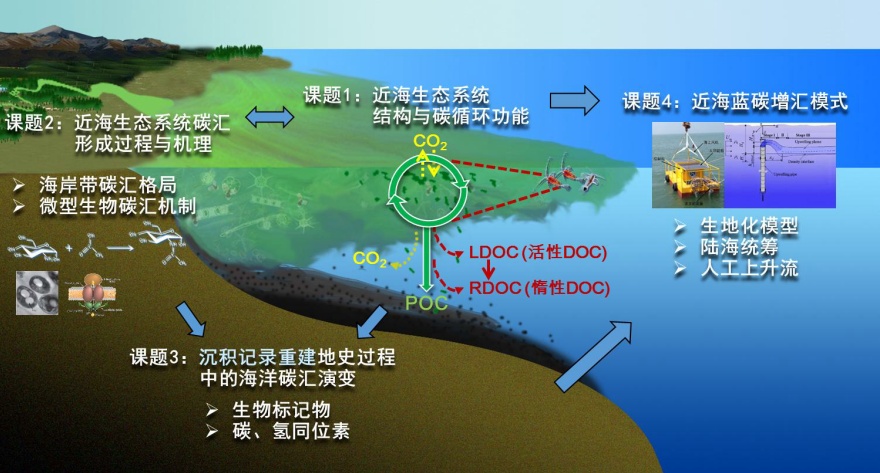国家重点研发计划“全球变化及应对”专项,2016-2021,首席科学家:张瑶
National Key Research and Development Program, 2016-2021, Leading PI: Yao Zhang
海洋是地球上最大的碳库,发挥着全球气候变化“缓冲器”的作用。蓝碳,即由海洋生态系统捕获的碳(主要是有机碳),是海洋储碳的重要机制之一。蓝碳最初认识的形式是可见的海岸带植物固碳。但之前没有得到足够重视的、看不见的微型生物(浮游植物、细菌、古菌、原生动物)占海洋生物量90%以上,是蓝碳的主要组分。我国近海占国土总面积的1/3,碳汇潜力巨大,亟待研发。
因此,针对“近海碳汇对缓解气候变化的贡献和意义”这一具有重要战略意义的目标,“近海碳汇增汇要增到哪里?其过程机制及对全球变化的响应如何?是否可能实现可实施的减排增汇生态工程?”成为摆在我们面前的核心科学问题。该项目通过微观与宏观结合、古今链接研究近海碳库变动与全球变化的关系,评估自然过程和人类活动对碳汇的影响;阐明近海碳循环过程与碳源汇变化过程及蓝碳增汇机制,建立海洋碳汇的指标体系和陆海统筹的近海增汇模式。
近海增汇,一是增加颗粒有机碳输出埋藏、二是增强微型生物介导的惰性溶解有机碳的产生(这个碳库相当于大气二氧化碳总量)。项目共设置四个课题。

课题1,近海生态系统结构与碳循环功能,课题负责人:张瑶(厦门大学)
摸清环境中群落结构的特征和演替规律;围绕颗粒有机碳输出和惰性溶解有机碳产生的一系列相关碳循环过程,了解和认识微型生物在其中的生态特性及其功能。
课题2,近海生态系统碳汇形成过程与机理,课题负责人:崔球(中科院青能所)
从群落、物种、基因、蛋白、代谢产物等水平上分析海洋生物对碳的吸收、合成、转运和释放机制,构建碳代谢关键路径;认识人为活动和陆源氮、磷输入对上述过程的影响。
课题3,沉积记录重建地史过程中的海洋碳汇演变,课题负责人:赵美训(中国海洋大学)
课题1 中涉及的输出埋藏到沉积物的颗粒有机碳,课题1 和2 同时涉及的不易降解的惰性溶解有机碳分子,以及课题2 中涉及的人为活动、陆源输入,将通过课题3的沉积记录(生物标记物和碳、氢同位素),重建地史过程中的海洋碳汇演变,从而古今链接研究近海碳库变动与过去历史上全球变化事件的关系。
课题4,近海蓝碳增汇模式,课题负责人:齐家国(浙江大学)
基于前3个课题的现场调查、理论探索、历史再现,通过生地化模型、全球变化模拟,给出陆海统筹的河口增汇和基于人工上升流的典型陆架海区增汇模式和示范。
该项目的预期产出之一近海碳汇形成过程与调控机制,及其与环境、与气候变化的关系将引领国际前沿;产出之二海洋碳汇指标体系和标准体系将支撑国家碳交易和气候谈判;产出之三陆海统筹近海增汇模式将落实生态补偿定量化示范,支撑海洋生态系统和沿海经济社会可持续发展。
Ocean is the largest carbon pool on earth, serving as the buffer of global climate change, absorbing about 1/3 of CO2 produced by human activities. Carbon sink captured by marine ecosystem is called the "Blue Carbon Sink" (hereinafter referred to as "blue carbon"), which is one of the most important mechanisms for the sea to store carbon. The initial form of blue carbon is visible plant carbon sequestration in the coastal zone. As a matter of fact, the invisible microorganisms (phytoplankton, bacteria, archaea, and protozoa), which have always been ignored, account for 90% of the marine biomass and constitute the main component of blue carbon. The marginal sea covers one third of the total territory of China, and it is of urgent need to explore the immense potential of carbon sinks. This project aims at the key processes and mechanisms of the carbon sequestration in coastal ecosystems and ways to increase ocean carbon sink.
An increasing carbon sink, on the one hand, refers to increasing the sinking and burial of particle organic carbon (POC) in sediments; and on the other hand, it is about increasing the production of refractory dissolved organic carbon (RDOC) mediated by microorganisms (the overall amount of the RDOC pool is equal to that of CO2 in the atmosphere). This project is comprised of four subprojects.
Subproject 1 (PI: Yao Zhang, Xiamen University) focuses on community structure and ecosystem function in the carbon cycle, with an emphasis on key processes concerning the POC sinking and the RDOC production.
Subproject 2 (PI: Qiu Cui, Qingdao Institute of Bioenergy and Bioprocess Technology, CAS) focuses on physiological and molecular mechanisms of ocean carbon sinks, such as uptake, transformation, and release of carbon-containing chemical compounds by microorganism at the gene and protein levels. This subproject also focuses the impact of human activities and input of terrestrial nitrogen and phosphorus on the above processes.
Subproject 3 (PI: Meixun Zhao, Ocean University of China) focuses at re-establishing the evolution process of ocean carbon sinks in geologic history with sedimentary records, which should record organic carbon from burial of sinking POC in sediments studied in subject 1, the RDOC molecules studied in both subproject 1 and 2, and the human activities and input of terrestrial sources studied in subproject 2, and aims at the relationship between ocean carbon sinks and global climate changes in ancient oceans.
Based on field investigation, theoretical analysis and historical representation of the subproject 1, 2, and 3, subproject 4 (PI: Jiaguo Qi, Zhejiang University) aims at establishing scenario models for carbon sink dynamics under global warming situation, and providing theoretical and technical foundations for engineering ocean carbon sequestration in the future.
This project is featured in its interdisciplinary cooperation and integration. Potential breakthroughs are especially expected in the following aspects: (1) key processes and regulatory mechanisms of ocean carbon sink and its relationship with environment and global climate changes; (2) an index system for carbon storage including a series of physical-chemical and biological indices and parameters and main core measurements protocols; (3) demonstrations of increasing carbon sink and engineering carbon sequestration in the ocean. These outputs will support the sustainable development of marine ecosystem and national carbon emissions trading.